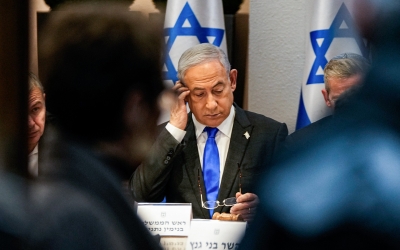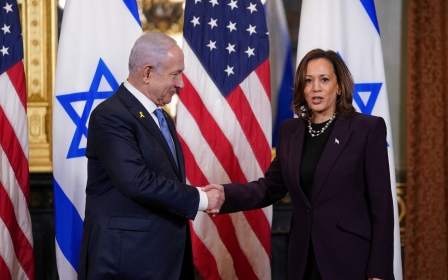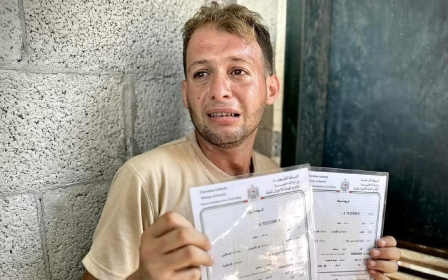Gaza ceasefire talks enter new round with low expectations. What's stopping the deal?

A new round of indirect negotiations for a ceasefire between Israel and Hamas to put an end to the devastating war on Gaza is set to begin on Thursday in Qatar.
But with a ceasefire proposal having been on the table for several months now, and with Hamas uncommitted to attending the latest round of talks, the chances of striking a deal appear marginal at best.
US State Department deputy spokesperson Vedant Patel told reporters on Wednesday that Washington has been assured by Qatar that Hamas will be represented at the talks.
"Our Qatari partners have assured us that there will be representation from Hamas," Patel said.
Reuters reported Wednesday that CIA director William Burns will attend talks and be accompanied by Brett McGurk, White House coordinator for the Middle East and Africa.
New MEE newsletter: Jerusalem Dispatch
Sign up to get the latest insights and analysis on Israel-Palestine, alongside Turkey Unpacked and other MEE newsletters
As the talks have largely stalled, Israel's assault on the Palestinian enclave has maintained its intensity. An Israeli strike on a school-turned-shelter on Saturday killed around 100 Palestinians, most of whom were children and the elderly.
Meanwhile, regional powers have signalled preparations for the breakout of a larger war, with the United States deploying a nuclear submarine and an aircraft carrier to the Middle East.
Middle East Eye takes a look at the current state of the ceasefire negotiations and why they have dragged on for months with little progress.
What happened to May's ceasefire proposal?
In early May, Hamas announced it had accepted a US-mediated ceasefire proposal. The announcement came as CIA director Burns was leading indirect talks with Hamas to achieve a breakthrough in the talks.
Middle East Eye obtained a copy of this proposal and published it on 7 May. The proposal was made up of three phases, each lasting six weeks and ending with a permanent ceasefire.
The first phase details the Israeli withdrawal from populated areas in Gaza, the unconditional return of displaced Palestinians to northern Gaza and the release of up to 33 living Israeli captives in exchange for approximately 1,000 Palestinian prisoners.
The second phase begins with a permanent cessation of military operations, including the complete withdrawal of Israel from Gaza, as well as the release of the remaining captives held by Hamas.
This release would be in exchange for a number of Palestinian prisoners to be agreed upon during the first phase of the ceasefire.
In the third stage, both parties exchange the remains of dead captives and prisoners on either side. A Gaza reconstruction plan, which should be finalised during the second phase, commences in the third phase. That plan also includes an end to the siege on the Gaza Strip.
After Hamas announced it accepted this proposal, Israel launched a military incursion into Rafah, the southernmost city in Gaza that had previously been deemed a red line by US President Joe Biden. The US described the attack as a "limited operation" and not the type of attack Washington was opposed to.
At the end of May, Biden announced a "comprehensive" ceasefire proposal and declared it was time for the war on Gaza to end. That agreement appeared identical to the deal Hamas accepted at the beginning of the month.
Since then, talks have been taking place, but a finalised agreement has yet to be achieved.
Key points of contention
As the indirect talks between Israel and Hamas have continued to drag on, one of the main issues has been over the second and third phases of the ceasefire.
In May, Israel proposed that its troops would leave the border area between Gaza and Egypt, known as the Philadelphi Corridor. However, several reports have stated that Israel has added new stipulations, asserting it would not withdraw from that buffer zone.
Another stipulation is that Israel is insisting on having a corridor running from east to west that runs through the middle of the Gaza Strip. In that corridor, Israeli forces would screen Palestinians returning to the north, in what it says would be a measure aimed at stopping Palestinian fighters.
Hamas has rejected this, saying this is an Israeli move to prevent Palestinians from returning to their homes in the north of the enclave.
Patel, the State Department spokesperson, declined to comment on these reports, saying that the talks are continuing along the lines of the original agreement.
"The ongoing conversations have and continue to have the contours of the plan President Biden laid out at the end of May," Patel said.
Over the past two months, Israeli Prime Minister Benjamin Netanyahu has also vowed to continue the war and has said he would not accept a permanent ceasefire until Hamas is eliminated.
Another major development is the killing of an Israeli captive held by Hamas. Hamas's armed wing, the Izz al-Din al-Qassam Brigades, announced this week that one captive was killed and two women captives were injured in two separate incidents.
The group said it formed a committee to investigate the incident but didn't provide further details. It's the first time Hamas publicly announced that it had killed a hostage.
Israel is escalating
Amid the ongoing negotiations, Israel has launched several extraterritorial military attacks that could potentially see its war on Gaza expand to a regional war.
On 30 July, Israel killed Hezbollah senior commander Fuad Shukr in a strike in the Lebanese capital of Beirut.
Days later, Hamas leader Ismail Haniyeh was killed while visiting Tehran, in what Hamas said was a targeted Israeli attack.
Since then, Iran has vowed to respond to the attack, raising fears of a wider escalation in the war.
For the past two weeks, American officials have said that an Iranian attack on Israel is imminent, and Washington has deployed a nuclear submarine and an aircraft carrier to the Middle East.
US envoy Amos Hochstein is in Lebanon to prevent escalations in the region and said on Wednesday he believed an all-out war between Hezbollah and Israel was avoidable.
But a finalised ceasefire agreement would be needed without delay, he said.
Middle East Eye delivers independent and unrivalled coverage and analysis of the Middle East, North Africa and beyond. To learn more about republishing this content and the associated fees, please fill out this form. More about MEE can be found here.






